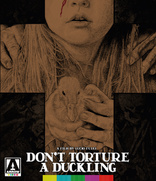Don't Torture a Duckling Blu-ray Movie
HomeDon't Torture a Duckling Blu-ray Movie 
Non si sevizia un paperino / Blu-ray + DVDArrow | 1972 | 105 min | Not rated | Oct 03, 2017
Movie rating
7.3 | / 10 |
Blu-ray rating
| Users | 0.0 | |
| Reviewer | 4.0 | |
| Overall | 4.0 |
Overview
Don't Torture a Duckling (1972)
A reporter and a young woman try to solve a series of child killings in rural Italy.
Starring: Florinda Bolkan, Barbara Bouchet, Tomas Milián, Irene Papas, Marc PorelDirector: Lucio Fulci
| Horror | Uncertain |
| Foreign | Uncertain |
| Mystery | Uncertain |
| Thriller | Uncertain |
Specifications
Video
Video codec: MPEG-4 AVC
Video resolution: 1080p
Aspect ratio: 2.35:1
Original aspect ratio: 2.39:1
Audio
Italian: LPCM Mono (48kHz, 24-bit)
English: LPCM Mono (48kHz, 24-bit)
BDInfo
Subtitles
English SDH
Discs
Blu-ray Disc
Two-disc set (1 BD, 1 DVD)
DVD copy
Packaging
Slipcover in original pressing
Playback
Region A, B (locked)
Review
Rating summary
| Movie | 3.5 | |
| Video | 4.0 | |
| Audio | 3.5 | |
| Extras | 5.0 | |
| Overall | 4.0 |
Don't Torture a Duckling Blu-ray Movie Review
Reviewed by Jeffrey Kauffman September 25, 2017Note: While care has been taken to not reveal any out and out spoilers in the following summary, contextualizing some of Don’t
Torture a Duckling means that hints are unavoidably dropped, meaning if you’re a good “between the lines” reader and don’t want any
surprises given away, you are encouraged to skip down to the technical portions of the review, below.
At least some Italian Roman Catholics have the kind of relationship with their religion which might cause them to post a social media status about
it along the lines of “it’s complicated”. While some American Roman Catholics are probably still reeling in the wake of the abuse scandals
documented so disturbingly in Spotlight, many Italians have had love/hate
relationships with both their overall religion and their individual priests in any number of films for decades, and among those Italians might be
numbered Lucio Fulci, who himself contributed to this somewhat odd canon of “questioning” films with his own output. While Fulci biographer
Troy Howarth goes to some lengths to discount any ideas that Fulci or at least Don’t Torture a Duckling is anti-Catholic (in his
commentary included on this Blu-ray as a supplement), there’s little doubt that Fulci didn’t necessarily conform to standard ideas of respect and
awe when it came to both religious iconography and in fact the concepts that iconography seeks to “describe”. Don’t Torture a Duckling
was Fulci’s first real breakthrough in his native Italy, and according to Howarth it remained Fulci’s own personal favorite of his films. In a number
of ways it’s a rather interesting giallo, and one which might even be thought of as an anti-giallo, at least in terms of its setting
(far removed from the typical urban environment many gialli employ). Don’t Torture a Duckling takes place in a remote Italian
village, and as such there’s more of a rustic quality to the proceedings than in many other gialli, along with an underlying sense of
“community” that is often missing in gialli that actually exploit the fractured aspect of living in a big city. The film begins with a kind of
bizarre sequence which introduces a seemingly troubled woman named Maciara (Florinda Bolkan) on a scenic hillside next to a really impressively
long elevated highway, a scene which suggests both the isolated environment of the film as well as perhaps a subliminal suggestion that this
setting is a long drive away from modern civilization. Maciara is digging in the dirt on the hillside, and the film’s first (of many) shocking
revelations is that she’s disinterring the skeletal remains of an infant. Armchair sleuths who are already aware there are going to be a series of
horrifying deaths in this film may take this opening scene as a salient clue, but Don’t Torture a Duckling is virtually bursting at the seams
with red herrings, and so it’s best not to come to any premature conclusions about what’s actually going on.
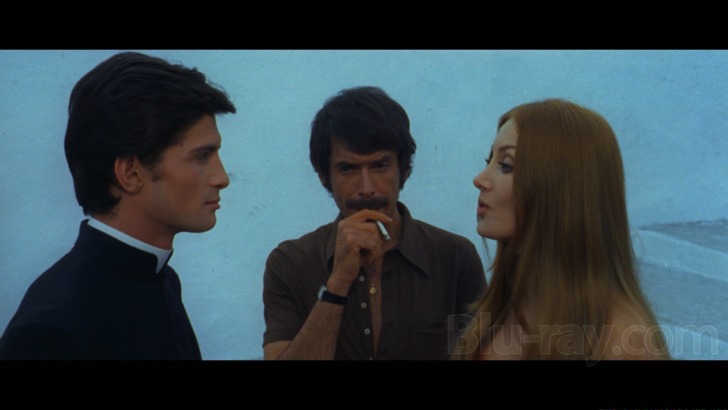
While Maciara’s penchant for voodoo dolls fingers her as someone with a pagan sensibility decidedly at odds with the more conforming Catholic views of the village as a whole, Fulci ups the “suspect” angle by clearly indicating that those very voodoo dolls are being used as totems for a number of the village’s young boys, many of whom end up dead, often under horrifying circumstances. It’s rather interesting, then, that before Maciara herself comes under the suspicion of the local police force, it’s another village outsider, a mentally deficient man named Giuseppe Barra (Vito Passeri), who is initially accused of having murdered the first victim. Attempting to bring order to a town verging on the edge of hysteria is Don Alberto Avallone (Marc Poreli), the local priest whose home for boys housed several of the victims.
Fulci’s anarchic tendencies are fully on display in a number of provocative ways. One of these is that the character who turns out to be the (more or less) heroine of the piece, a young heiress named Patrizia (Barbara Bouchet), is (again, very clearly) shown to be a woman of somewhat loose morals, and in fact her introduction in the film offers her stark naked, reclining on a couch and laughingly titillating a young pre-pubescent boy. The other focal character is a journalist named Andrea Martelli (Tomas Milian), who kind of surprisingly only really teams up with Patrizia fairly late in the story, but who is shown to have a better handle on what’s happening than several of the local police force, in what is perhaps another piece of Fulci’s social critique puzzle.
But Fulci never really strays far from a religious subtext, often subverting traditional meanings or at least assumptions, as when one of the sad victims thinks he's found refuge under a large outdoor crucifix, only to be slaughtered mercilessly. But even the victims don't escape Fulcri's sometimes jaundiced observational eye, and as Howarth points out repeatedly, the little boys who end up dead are seen engaging in a number of potentially objectionable activities. In a way, then, Don't Torture a Duckling might be thought of us as someone tearing away whatever the Italian version of a quaint and cozy Norman Rockwell representation would be to reveal a nightmarish Hieronymous Bosch reality lurking underneath.
The film tips over into a bit of ridiculousness as it wends its way toward an almost humorously hyperbolic conclusion. Even Howarth, who confesses he's an unabashed fan of the film, seems to realize that one specific effect used to document the fate of the culprit is ineffective (to be kind). But Don't Torture a Duckling is a rather unique take on some traditional gialli tropes, while at the same pretty much completely avoiding other well worn aspects of the genre (there's no cloaked, gloved figure wreaking havoc in this film). The fact that somehow Fulci and his team managed to get a Donald Duck figurine into this far from family friendly outing without being sued for everything they were worth by Disney is perhaps indicative of the fact that whomever Fulci himself prayed to was responsive.
Don't Torture a Duckling Blu-ray Movie, Video Quality 
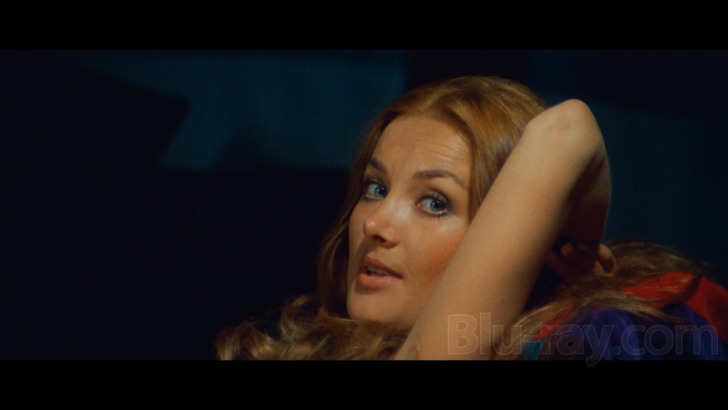
Don't Torture a Duckling is presented on Blu-ray courtesy of Arrow Video with an AVC encoded 1080p transfer in 2.35:1. Arrow's insert booklet contains a much longer and more detailed account of this film's restoration, written by Torsten Kaiser, Technical Director of TLEFilms Film Restoration and Preservation Services. Mr. Kaiser goes into quite a bit of interesting information, including the fact that Don't Torture a Duckling was filmed utilizing the supposed cost saving technique of Techniscope, which reduced production costs by halving the standard exposed area of a single frame of 35mm film from four perforations to two. This created a whole cascade of subsequent issues, including the need for standard 4-perf prints to be created in what amounts to a "blow up". Kaiser also gets into what sounds like an interstitial situation where initial scans weren't up to snuff, but the original camera negative's fragility meant it couldn't leave Italy. Those interested are strongly encouraged to read Mr. Kaiser's full account, but to get down to basics, here's the gist of the sources utilized:
Don't Torture a Duckling was digitally restored in 2K throughout the entire workflow. For this restoration the original 2-perf Techniscope Eastman camera picture negative and a 4-perf 35mm duplicate negative were used. Since the film elements could not leave the country, the scanning was done at LVR Digital in Rome, Italy on a 2K DSX Cintel Scanner.This brief quote really only hints at what sounds like a major technical challenge, including differences between the 2-perf OCN and a 4-perf intermediate negative used as a reference, as well as color timing challenges due to the fact that this was filmed on Eastman Kodak color stock but had its prints processed on Technicolor print stock.
While there are certain variances in sharpness, clarity and grain resolution, as well as very slight density fluctuations, this is a really nice looking transfer that boasts an impressively strong palette. The outdoor material (which is copious) offers really beautifully saturated blue skies and generally excellent detail in potentially problematic material like dense foliage. Some selected scenes don't quite pop with the same vividness (see screenshot 13, which also shows a bit more fuzziness than some other sections of the presentation). A few selected moments lack significant detail levels (see screenshot 5), but on the whole when brighter lighting is employed, both general detail and fine detail levels are quite good, as can be seen in several of the screenshots accompanying this review. A couple of problematic moments, including opening and closing credits and the final showdown on the cliff, are noted in Mr. Kaiser's comments as presenting even more technical challenges than the rest of the restoration.
Don't Torture a Duckling Blu-ray Movie, Audio Quality 
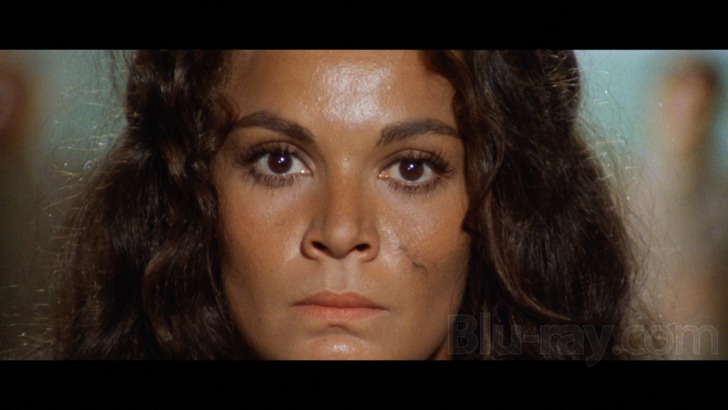
Don't Torture a Duckling features LPCM Mono tracks in both Italian and English. As was the case in Italian cinema in those days, the entire film was post-looped (in both languages), and so as Mr. Kaiser's notes mention, audio synch can be at least slightly loose at times. Both of these tracks show occasional boxiness, along with some passing minor distortion in moments like what sounds like a pan pipe cue in Riz Ortolani's score, but there's nothing here I'd term overly problematic or even very distracting. Dialogue comes through the gauntlet fine, though I personally found the English language voice acting pretty lackluster.
Don't Torture a Duckling Blu-ray Movie, Special Features and Extras 
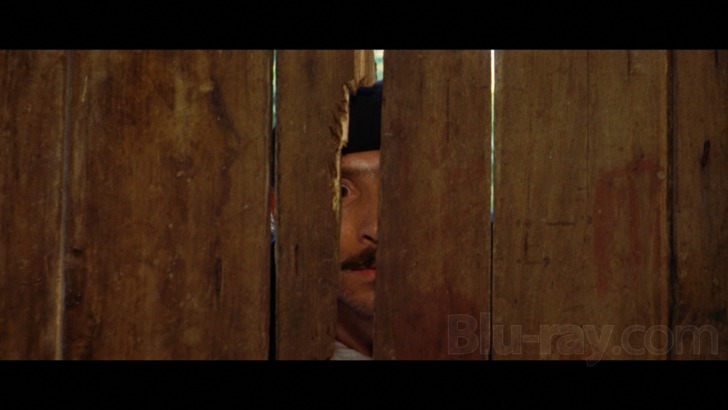
- Audio Commentary is by giallo expert Troy Howarth, and covers both biographical data on the participants as well as a wider conversation about some of the film's themes.
- Giallo a la Campagna (1080p; 27:44) features giallo expert Mikel J. Koven, in a "video conversation" covering the genre in general and this film in particular. This comes with a spoiler warning.
- Hell is Already in Us (1080p; 20:30 ) is a video essay by Kat Ellinger, supposedly (according to the description on the menu) about Fulci's misogyny but really a bit more wide ranging than simply that. This also comes with a spoiler warning.
- Lucio Fulci Remembers is culled from 1988 audio interviews with journalist Gaetano Mistretta (actually just tapes of Fulci replying to
written questions submitted by Mistretta). These play out to arty shots of a reel to reel tape recorder and memorabilia related to Fulci.
- Part 1 (1080i; 20:13)
- Part 2 (1080i; 13:12)
- Cast and Crew Interviews include
- Florinda Bolkan (1080p; 28:20)
- Sergio D'Offizi (1080i; 46:21)
- Bruno Micheli (1080i; 25:38)
- Maurizio Trani (1080p; 16:03)
Don't Torture a Duckling Blu-ray Movie, Overall Score and Recommendation 

Don't Torture a Duckling has a lot of patently provocative material, but it may undercut its serious aspects with some unneeded elements and a way overheated finale. But this is a really fascinating combination of giallo tropes with a rather trenchant undercurrent of social (and, yes, religious) criticism that certainly indicates Fulci was more than just the "godfather of gore". With an understanding of the immense technical challenges this restoration required, technical merits are strong, and as is often the case with Arrow releases, the supplements are outstanding. Recommended.
Other editions
Don't Torture a Duckling: Other Editions
Similar titles
Similar titles you might also like

A Lizard in a Woman's Skin
Una lucertola con la pelle di donna
1971

Deep Red 4K
Profondo rosso
1975

Strip Nude for Your Killer
Nude per l'assassino
1975

Tenebrae 4K
Standard Edition
1982

The Bird with the Crystal Plumage
L'uccello dalle piume di cristallo | Remastered
1970

Cat in the Brain
Un gatto nel cervello | Glow in the Dark Cover & Mini Portrait of Lucio Fulci Limited Edition to 3000
1990

The Perfume of the Lady in Black
Il profumo della signora in nero
1974

The Beyond 4K
...E tu vivrai nel terrore! L'aldilŕ / Seven Doors of Death | Standard Edition
1981

The New York Ripper 4K
Lo squartatore di New York
1982

Zombie 4K
Zombi 2 / Zombie Flesh Eaters
1979

Inferno
1980

Blood and Black Lace
Sei donne per l'assassino
1964

What Have You Done to Solange?
Cosa avete fatto a Solange?
1972

Torso 4K
I corpi presentano tracce di violenza carnale | Carnal Violence | Limited Edition
1973

The Psychic
Special Edition | Sette note in nero | 4K Restoration
1977

Slaughter Hotel
La bestia uccide a sangue freddo / Asylum Erotica
1971

The Cat o' Nine Tails 4K
Il gatto a nove code | Special Edition
1971

The Bloodstained Shadow
Solamente nero
1978

Death Smiles on a Murderer
La morte ha sorriso all'assassino
1973

Evil Eye
Featuring The Girl Who Knew Too Much / La ragazza che sapeva troppo
1963
